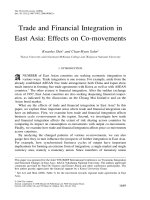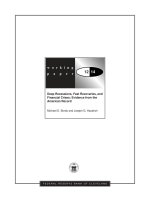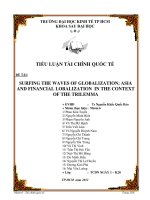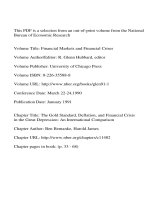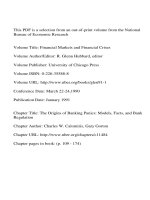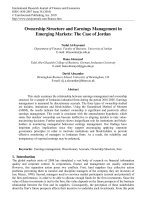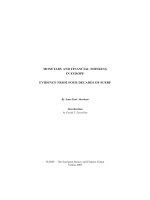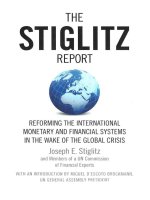radonjic & kokotovic - keynes, minksky and financial crises in emerging markets (2014)
Bạn đang xem bản rút gọn của tài liệu. Xem và tải ngay bản đầy đủ của tài liệu tại đây (4.4 MB, 269 trang )
Ognjen Radonjić and Srdjan Kokotović
UNIVERSITY OF BELGRADE
FACULTY OF PHILOSOPHY
OgnjenRadonjić andSrdjanKokotović
Keynes, Minsky
and Financial Crises in Emerging Markets
UNIVERSITY OF BELGRADE
FACULTY OF PHILOSOPHY
One of the most important, yet perhaps still under‐appreciated lessons of the global
financialcrisisof2007 ‐09concernstherolethatacademiceconomicsplaysintoday’ssocietyand
politics.Alongwiththerevelationsabouttheskewedincentivestructureinthefinancialindustry,
short‐termism in national economic policies, dogmatic thinking at the levels of international
economicsinstitutionsandcontroversialprocessesof financialinnovation, thecrisis hasexposed
mainstream academic economicsas a closed‐mindedenterprise,worryinglynarrow in itsscope
and mission, and increasingly detached fromthe analysis of economic realities. As part of this
transformation in academic economics, studying economic history and learning from the rich
historyoftheprofession,hasbeencrowdedouttothemarginsofeconomics.
Keynes, Minsky and Financial Crises in Emerging Markets represents a long‐needed
attempt by economists to depart from this sad trend. Radonjić and Kokotović focus on the
evolutionoffinancialstructuresandthewaythisprocesshasbeen analysedby , ontheonehand,
economicorthodoxy, andheterodoxscholarssuch asJohn Maynard Keynes and Hyman Minsky,
on the other. At the very centre of the book’s critique is the relationship between privately
createdcredit instrumentsandpublic, or official monetarysupport to the economy. Focusingin
depth of the anatomy offinancial instability and crises, the authors chart the evolution of key
conceptual approaches to financial crisis, and examine in dept h thekey cases of fragility, crises
and crashes of the past threedeca des. Their rigorous,reflexive and well‐documented empirical
analysisillustratestheeffectsofkeyprocessesofendogenouscreditatworkindifferentpolitical‐
economycontexts:emergingeconomiesinLatinAmerica,EastAsia andEasternEurope,and the
advancedeconomiesof Anglo‐Saxon capitalism. Carefully tracing the development ofacademic
thoughton finance over thepast few decades the authorspresent adynamic, critical and well‐
informedportrayalofthefinancialsystemdrivenbyprivatefinancialinnovationyetdependanton
public liquidity provisionin times of crises. Their analysisof this c ontroversy makes this text a
must‐readforallstudentsoffinancialcapitalismpost‐2008,andavaluableresourcetothosewho
aimtolessentheeconomicburdenoffinancialcrisesinthefuture.
AnastasiaNesvetailova
CityUniversityLondon
Keynes, Minsky
and Financial Crises
in Emerging Markets
Филозофски факултет, Универзитет у Београду │ 2014
K
eynes, Minsky and
Financial Crises
in Emerging Markets
K
Ognjen Radonjić
Srdjan Kokotović
Ognjen Radonjić
Srdjan Kokotović
Keynes, Minsky and Financial Crises
in Emerging Markets
First edition, Belgrade 2014.
Publisher:
Faculty of Philosophy, University of Belgrade
Čika Ljubina 18-20, Belgrade 11000, Serbia
www.f.bg.ac.yu
For the publisher:
Miloš Arsenijević
Dean of the Faculty of Philosophy
Reviewers
Miodrag Zec (University of Belgrade)
Boško Živković (University of Belgrade)
Marc Lavoie (University of Ottawa)
Anastasia Nesvetailova (City University London)
Proof reading:
Charles Robertson
Printing:
„Službeni glasnik“, Belgrade
Print run:
300
ISBN 978-86-88803-55-7
Publishing of this book was supported by the Ministry of Education,
Science and Technological Development of the Republic of Serbia
Acknowledgements
We are sincerely thankful for valuable comments and suggestions to
professors Miodrag Zec, Boško Živković, Pavle Petrović, Marc Lavoie and
Anastasia Nesvetailova.
The analysis, findings, and conclusions expressed in this book are en-
tirely those of the authors and do not represent the views of either the
University of Belgrade or the National Bank of Serbia. Any error remains
an exclusive responsibility of the authors.
To my friend and mentor,
professor Miodrag Zec
Ognjen Radonjić
To Milica, Dunja and Nadja,
my beloved three princesses
Srdjan Kokotović
Even if you are a minority of one, the truth is the truth.
Mahatma Gandhi
Measure, value, that which endures in the transient world–
all disappear. They are replaced by nihilism, the cult of worthlessness.
Truth is reduced to an empirical or mathematical reality and is no
longer the ideal to which reality should aspire. The truth sets us free
because it has power over us; it gives us instructions,
not the other way around.
Rob Riemen,
Nobility of Spirit. A Forgotten Ideal
| 9
Table of contents
13 | Foreword by Professor Marc Lavoie
15 | Introduction
23 | I Exegesis of the Conventional Wisdom: Efficient Markets,
Rational Expectations and Exogenously Generated Financial
Crises
24 | 1. Vanguards to the Efficient Markets Hypothesis
25 | 2. The Efficient Financial Markets Theory: Birth and
Implications
28 | 3. Exogenously Generated Speculative Bubbles and
Financial Crises
31 | 4. Orthodox Views on International Financial Crises
35 | 5. Assumptions of the EMH: Ab Absurdo
36 | 5.1. Risky and immutable future
40 | 5.2. The degree of risk-aversion and expectations of rational
agents are exogenous
41 | 5.3. Expectations of rational agents are homogenous
42 | 5.4. Uncorrelated trades of irrational investors
43 | 5.5. Correlated trades of irrational investors and stabilizing
actions of rational arbitrageurs
44 | 5.6. Any security has always-available perfect or almost
perfect substitute and agents have unrestricted, ready
available access to credit
44 | 5.7. Neutrality of money
50 | II Keynes’ U-turn: Endogenous Expectations, Speculative
Financial Markets and Instability of Investment Demand
51 | 1. Probability, the Weight of Argument and Fundamental
Uncertainty
53 | 2. Non-neutrality of Money, Liquidity Preference and
Keynes’ Rejection of Saw’s Law
10 | Keynes, Minsky and Financial Crises in Emerging Markets
58 | 3. The Nonergodic Economic System and the Short and
Long-Term Expectations of Entrepreneurs
61 | 4. Dual Price Investment Theory, Conventional Decision-
Making and Speculative Financial Markets
67 | 5. Flimsy Expectations, Propensity to Hoard and Instability
of Investments
68 | 6. Speculative Bubbles, Busts and Business Cycles
72 | 7. Destabilizing Arbitrage and Speculative Gains of Rational
Arbitrageurs
77 | III Hyman Minsky: Endogenous Instability, Debt and Fragile
Finance
78 | 1. Banality of Neoclassical Synthesis and the Wall Street
Paradigm
83 | 2. Minsky’s financial theory of investment
86 | 3. The FIH
89 | 4. Dynamics of the FIH: Endogenous System Transition
from Robustness to Financial Fragility
95 | 5. Endogeneity of Money and Central Bank’s Limits in
Controlling Money Supply
97 | 6. The FIH in Open Economy
99 | 7. Investment versus Liquidity Model of Capital Flows from
Developed to Developing Countries
100 | 8. The Anatomy of Minskyan Crisis in Open Economies
102 | 9. From Boom to Bust
106 | 10. Third Generation Models of International Financial
Crisis
108 | 11. Some Other Alternative Views
111 | IV The Fallen Angels: Mexico and the Asian Tigers
112 | 1. The Mexican Tequila Party and Hangover
126 | 2. The Asian Flu: Per Astra ad Aspera
146 | V Financial Tumbling in Eastern Europe: From the Ashes of
Socialism to the Dust of Capitalism
147 | 1. Prelude to Financial Crisis in Eastern Europe: Global
Savings “Glut”, Subprime Crisis and the Global Credit
Crunch
Table of Contents | 11
147 | 2. Cheap Money Policy in the U.S.
149 | 3. Securitization of Mortgages and Rise of the Subprime
Market
155 | 4. The Great Moderation
157 | 5. Liquidity Expansion in the U.S. and Ensuing Expansion of
Emerging Markets
159 | 6. Subprime Crash and the Global Credit Crunch
160 | 7. Preventing a Global Debt Deflation Episode
161 | 8. Financial Fragility and Instability in Eastern Europe:
Cross-Country Analysis
163 | 8.1. Shaken Foundations: The Euro Area
169 | 8.2. Eastern Europe: Boom and Crisis
200 | VI Cross-Country Analysis of Individual Vulnerabilities of the
Eastern European Economies to the Sudden Liquidity Contraction
203 | 1. Factual Results and the Analysis of Individual
Vulnerabilities
228 | VII Financial Turmoil Now and Then: Empirical Comparison
of the Eastern European and Previous Financial Crises
231 | 1. Factual Results
245 | Conclusion
255 | References
265 | Data Sources
| 13
Foreword
The global financial crisis that started in August 2007 has shown, if
such a demonstration was still needed after the Asian crisis of 1997, that
financial markets need to be tamed. The great British economist, John
Maynard Keynes, who was a strong proponent of capital controls and who
did not believe in the self-equilibrating forces of unfettered markets, cer-
tainly understood this. This mistrust in the self-regulating forces of capi-
talism, despite its dynamic and entrepreneurial features, was also clearly
expressed by the American economist Hyman P. Minsky. This university
professor and bank advisor devoted his academic career to explaining why
banks and other financial institutions were prone to euphoria and how
this excessive optimism was likely to generate ever more fragile balance
sheets. This financial fragility, despite the apparent robustness of the econ-
omy, would lead to a financial crisis which would require the intervention
of the government and of the monetary authorities, failing which a debt-
deflation would occur, with falling asset prices and rising unemployment.
This is what I called in 1983 the paradox of tranquility.
Until 2008, the works of Minsky were known only to a small group
of post-Keynesian economists, bankers and portfolio managers, some of
which would meet every year at the Minsky conference held at the Levy
Economics Institute, located in a small town, two hours north of New
York City. Since 2008 however, all readers of the Wall Street Journal or of
the Financial Times know about the ‘Minsky moment’, when uncertainty
and the lack of trust and confidence make liquidity evaporate and inter-
est rates rise, leading to forced asset sales. Minsky’s books have been re-
issued, and the annual Minsky conference is now being held in New York
City, at the Ford Foundation, with hundreds of participants, including
many presidents of the US Federal Reserve Banks.
14 | Keynes, Minsky and Financial Crises in Emerging Markets
Ognjen Radonjić and Srdjan Kokotović do a marvelous job of recall-
ing the standard view of financial markets – the efficient market hypoth-
esis – as well as the rival views held by Keynes and Minsky, notably the
importance of liquidity, the flimsy foundations of market expectations, the
relevance of fundamental uncertainty, the difficulties encountered by cen-
tral banks and regulators, the possibly destabilizing behaviour of specula-
tors, and the endogenous transformation of a robust financial system into
a fragile one. Their personal contribution is their extension of Minsky’s
financial fragility hypothesis, developed within the context of the Ameri-
can economy, to an open economy setting, where unrestricted interna-
tional capital flows tend to fragilize the financial systems that at first sight
seem to benefit from these inflows. Radonjić and Kokotović provide their
readers with a unique contribution, by explaining (sometimes in painstak-
ing details) the evolution of the European emerging countries before and
after the global financial crisis in light of this Minskyan framework that
they have developed. Unfortunately, the problems inside of the eurozone,
which also arose as a consequence of unfettered financial flows as well as
the austerity policies pursued in Germany, are far from being over, and the
lessons that Radonjić and Kokotović draw from what happened during
the global financial crisis are likely to be useful sooner than later.
Professor Marc Lavoie
Department of Economics, University of Ottawa
May 2013
| 15
Introduction
We live in an ever-changing world of scientific and technological
progress, intensive international trade and large-scale capital flows. One
of the main features of the modern global economy in the last thirty years
or so is that, contrary to conventional wisdom, periods of tranquility are
transitory. Boom-bust episodes occur regularly in both developed coun-
tries and emerging markets; crises are erupting more frequently, lasting
longer and becoming more severe.
What can be seen at first glance is that the functioning of the financial
sector which, according to the textbooks provides effective diversification
of risk and the efficient allocation of scarce resources to optimal produc-
tive use, has become completely de-coupled from the real sector, which
financial markets are supposed to serve in the first place. In a word, fi-
nancial markets have become a purpose unto themselves. To illustrate this
point it is enough to point out that the volume of annual world financial
transactions is a multiple of productive real capital investments and the
value of global financial assets is well above the annual value of the world’s
GDP.
1
The same is true when we compare daily turnover in the global for-
eign exchange markets (prompt, forward and swap) and over-the-counter
derivative markets with the annual value of world trade or average annual
salary of those employed in the financial and the real sector.
2
These im-
1 The ratio of value of global financial assets to annual world output equaled 109% in
1980 and 313% in 2010. The value of global financial assets in 2010 was 198 trillion
US$ whereas the value of annual world output (in current prices) was 63.2 trillion
US$. The ratio of the value of global financial assets to the value of world invest-
ments in 2010 was equal to 1385%. (IMF, WEO database; Lim Mah-Hui 2008; The
Economic Times).
2 In 2010, the turnover in traditional foreign exchange markets (spot, forward, and
swaps) was equal to nearly 4 trillion US$ a day and the value of annual world exports
16 | Keynes, Minsky and Financial Crises in Emerging Markets
balances are of obvious significance in explaining the financial fragility of
the world economy.
Perhaps the worst feature of financial crises is that they cause long-
lasting suffering to common people and result in the redistribution of
global wealth to the benefit of a small number of the wealthiest people in
the world. Thus, it seems that Marx’s prophesy of increasing concentration
and centralization of power is coming true in our time. What we want to
explore in this study is why we are living in globally unstable economic
conditions and how economic theory explains this phenomena. How and
why do crises emerge, and is there anything we can do about it?
As we see it, the aim of any science, including economic theory, should
be to help humans to be humans, i.e. to create economically efficient but
at the same time just and balanced societies consisting of ordinary people
enjoying individual liberty and a decent and dignified life in harmony
with the natural environment. In order to accomplish this demanding
task, economic theory should be capable of approximating as precisely as
possible the characteristics of the real-world economic system in which
we live. Again, in order to do that, it is of crucial importance that the
theorist who studies the social phenomena be aware of the simple truth
that the motives and behavior of individuals are to a large extent, both
spatially and temporally, determined by the social context in which they
exist. If this important fact is overlooked, the danger of creating abstract
and general theoretical principles arises. These principles are supposedly
applicable to all occasions and all times and are independent of the social
environment. However, in real life, the applicability of these general and
abstract theoretical principles is essentially limited to a very small number
of cases. So, as we see it, theories that are the result of normative and ideo-
logically colored theorizing – what we would like something to be and not
as it really is – theories created independently of a spatially and tempo-
rally specified social context – are irrelevant.
One such theory is certainly the modern theory of efficient finan-
cial markets, firmly grounded in grossly unrealistic assumptions that the
future will resemble the past and that rational decision-markers are ca-
pable, on average, of forming correct expectations. No less important, to
this theory, humans, like automata, are assumed to form homogenous ex-
pectations and make decisions independently of decisions made by other
market participants. As the proponents of omnipotent free markets see
it, the future path of the economic system is predetermined and is not
dependent on the past or future choices of economic agents. If it was, and
of goods and services equaled 18.9 trillion US$. (IMF, WEO database; International
Business Times).
Introduction | 17
if the future were known, then every agent would have to be aware of the
real process by which expectations are formed and adjusted, as well as
the present and the future decisions of every agent in the system. Ironi-
cally, it is precisely the impossibility of gaining such vast knowledge that
led neoclassical economics to reject centrally planned systems (Crotty
1994). The direct implication of the efficient market hypothesis is that
free decentralized markets, if let alone, inherently, i.e. endogenously gen-
erate equilibrium. In this view, ups and downs (boom-bust episodes) are
the consequence of an exogenous shock (external to market processes),
most frequently inappropriate and clumsy public policy interventions. In
the open-economy model, financial crises can emerge due to a number
of factors; inconsistency between the internal and external objectives of
monetary authorities, a lack of credibility of the central bank’s and the
government’s commitment to fully defend the foreign exchange rate, mas-
sive withdrawals from the host country due to irrational behavior on the
part of lenders, corruption and cronyism etc. A superior recipe for avoid-
ing financial crises is to implement and conduct consistently prescribed
market-led policies. On the other hand, if these rules are not obeyed and
consequently crisis erupts, the only way to regain the confidence of inves-
tors, domestic and foreign, is to implement measures of economic auster-
ity. All in all, proponents of the efficient markets theory preach that self-
regulated markets led by Adam Smith’s “invisible hand” are the optimal
mechanism for rational and productive allocation of scant resources to
the most productive uses. If unanticipated exogenous shock disrupts the
normal functioning of markets, corrective forces that, at least in the long
run, restore market clearing conditions, will be activated.
On the other hand John Maynard Keynes and his most prominent
follower Hyman Minsky rejected the axioms of mainstream economics
that submit the general public to “market-place idols”. (Keynes 1937, p.
215). They rejected economics as a science of abstract and general theo-
retical principles for all ages, applicable to all occasions independently of
the social context. In their view, the future is fundamentally uncertain and
the longer the time horizon the less we are capable of predicting the future
path of the economic system. In other words, the future is not predeter-
mined, waiting to be discovered by the mighty rational men, but it is cre-
ated by the expectations-based actions undertaken by humans. Humans
are specific and mutually different, psychologically complex beings who
form heterogeneous expectations. How then, in a situation when he knows
that he does not know, i.e. when human decisions make the future and not
a deus ex machina, faced with very scant information, does a rational man
make decisions? Keynes argued that in turbulent and dynamic economic
environments, the decisions of agents are conventionally based. Decision-
18 | Keynes, Minsky and Financial Crises in Emerging Markets
making based on conventions does not produce optimal decisions, but it
is rational because it is the best that agents can do for themselves in condi-
tions of fundamental uncertainty.
Therefore, humans are not isolated, as orthodox theory assumes, but
are social beings whose preferences can be changed under social influ-
ence and the choices of other agents. Also, they make decisions in ac-
cordance with an institutionally established system of values.
3
To stress
a point, the behavior of humans must be observed and analyzed within
the framework of the social milieu in which they exist, not outside of it,
in some imaginary perfect and simplified world. “In an era when perfor-
mance failures demonstrate the need for economic reform, any successful
program of change must be rooted in an understanding of how economic
processes function within the existing institutions. That understanding is
what economic theory is supposed to provide. Thus, economic policy
must be concerned with the design of institutions as well as operations
within a set of institutions. Institutions are both legislated and the result of
evolutionary processes. Once legislated, institutions take on a life of their
own and evolve in response to market processes. We cannot, in a dynamic
world, expect to resolve the problems of institutional organization for all
time.” (Minsky 1986, pp. 3, 7). The essence of Keynes’ and Minsky’s dis-
equilibrium economics is that the invalid assumptions of orthodox theory
lead to invalid understanding of the capitalistic economic system and ac-
cordingly to wrong policy prescriptions. As Keynes put it: “The ideas of
economists and political philosophers, both when they are right and when
they are wrong, are more powerful than is commonly understood. Indeed
the world is ruled by little else. Practical men, who believe themselves to
be quite exempt from any intellectual influences, are usually the slaves of
some defunct economist.” (Keynes 1936, p. 404). Therefore, it is of quint-
essential importance to fully understand how the modern capitalistic eco-
nomic system works, since the diseases it catches from time to time, along
its evolutionary way forward, cannot be cured without an accurate diag-
nosis.
In his effort to make a correct diagnosis, Minsky stood upon the
shoulders of a giant (Keynes), “to see far and deep into the essential char-
acter of advanced capitalist economies.” (Minsky 1986, p. x). What he saw
is that in “ a world with capitalist finance it is simply not true that the
3 Changes in human practices stimulate and promote changes in institutions and vice
versa, thus propelled changes in institutions stimulate further changes in human
practices. Thus, the economic and social environment is in constant flux, in transi-
tion from one to the other state and general and abstract principles for all times and
situations are not applicable in the real world of modern capitalistic systems.
Introduction | 19
pursuit by each unit of its own self-interest will lead an economy to equi-
librium. The self-interest of bankers, levered investors, and investment
producers can lead the economy to inflationary expansions and unem-
ployment-creating contractions. Supply and demand analysis – in which
market processes lead to an equilibrium – does not explain the behavior
of a capitalist economy, for capitalist financial processes mean that the
economy has endogenous destabilizing forces. The major flaw of our
type of economy is that it is unstable. This instability is not due to external
shocks or to the incompetence or ignorance of policy makers. Instability
is due to the internal processes of our type of economy. The dynamics
of a capitalist economy which has complex, sophisticated, and evolving
financial structures leads to the development of conditions conducive to
incoherence – to runaway inflations or deep depressions.” (Ibid, pp. 11,
280). In his Financial Instability Hypothesis, a work widely neglected by
mainstream economists, Minsky argues that financial markets are the
heart of modern capitalist economies, which are prone to fragility, thanks
to the non-neutrality of money, division of ownership and management
in big corporations and financial institutions, the ever-growing and mas-
sive debt financing of uncertain investment projects over the business
cycle, continual financial innovation and fundamental uncertainty. In a
word, dynamic financial systems are in a constant flux, whereas periods
of calm are only transitional. Unstable optimistic and pessimistic expec-
tations of debt financed economic units endogenously lead the financial
system from the state of robustness towards financial fragility, in which
a sudden, unexpected appearance of endogenously and/or exogenously
created shock has the power to push the system into financial instability.
The fact that the focus of Minsky’s attention is a closed advanced capi-
talistic economy, certainly does not mean that his theoretical insights are
not applicable to an open-economy case. What is more, they are of crucial
importance in understanding why a global economy of unfettered capital
flows is so fragile and liable to disruption. Namely, in addition to the flaws
of a closed advanced market economy, there are several more in the case
of open developing economies which make them even more susceptible to
financial crises.
This does not mean that everything is gloom and doom, however,
only that there is an inherent need for an intense activist policy. Thus,
it is possible to constrain the inherent instability of modern economies
through active management of the economic system and regular updating
of regulatory practices by policymakers. As Minsky says: “Although the
full force of Keynes’s insights into the workings of a capitalist economy has
not been absorbed into the ruling economic theory and policy analysis,
20 | Keynes, Minsky and Financial Crises in Emerging Markets
enough of his message – that our economic destiny is controllable – has
come through to make conscious management of the economy ” (Ibid,
p. 8). If, on the other hand, regulators do not accomplish their task prop-
erly, instability is to be expected. In the event of financial crisis, Minsky
in genuine Keynesian tradition condemns austerity measures and calls for
Big Bank and Big Government policy interventions in order to prevent
debt-deflation and widespread devastating depressions.
The structure of this work is as follows: In the first chapter we analyze
in detail the assumptions of the modern mainstream theory of efficient
markets and its theoretical and policy implications. We conclude that in-
valid assumptions lead to invalid theory and therefore policy implications
which are not up to the task of solving a vast array of problems and grow-
ing difficulties in the normal functioning of the global economy. In the
next chapter we cover the economic thought of the great John Maynard
Keynes, one of the most influential and certainly the most controversial
social thinkers of all times. He was the first one who, in the aftermath
of the Great Depression, rejected the postulates of neoclassical economics
and offered his insights into the ways contemporary economies and es-
pecially financial markets function. He offered a disequilibrium oriented
theory of free markets which, if not constrained, lead to over or under
investment, overly optimistic or pessimistic expectations, and consequent-
ly booms and depressions, myopic investment strategies and speculative
financial markets. He also laid the ground for the future development
of the theory of business cycles, i.e. the shoulders upon which Minsky
stood in the process of making his Financial Instability Hypothesis. In the
third chapter we examine Minsky’s theoretical explanations as to why and
how neoclassical synthesis reduced Keynes to banality; why the capital-
istic mode of functioning of advanced economies in periods of stability
as well as instability sows the seeds of its own destruction; and why tight
and regularly updated regulation of the financial sector and active policy
management are needed in order to prevent and ameliorate outbursts of
runaway inflation and unemployment-creating contractions. We further
draw on the insights of Arestis and Glickman (2002), Kregel (1998) and
Pettis (2001a) to expand Minsky’s theoretical framework to the develop-
ing open-economy case in which most debt is foreign short-term debt set
on a roll-over basis and denominated in hard currency. In such a way,
as Pettis (2001a) argues, displacement or the key event that will trigger
massive capital movements towards developing countries is a Minskyan li-
quidity expansion in rich countries. In other words, movements of capital
towards developing countries are exogenous, i.e. the actions of developing
countries do not influence movements of international capital, which are,
rather, the result of liquidity changes in the developed world. On the other
Introduction | 21
hand, a liquidity expansion in the developed world and the following capi-
tal flows into the shallow financial markets of developing countries pro-
duce positive effects only in the short run. In the medium run, unless the
external borrowing of local market participants is adequately constrained
and controlled, a disastrous debt deflation episode may take place. In the
fourth chapter we conduct Minskyan analysis of the Mexican (1994) and
Asian crisis (1997). We conclude that in both cases, massive movements
of capital towards these markets were exogenously generated and that
a robust period in the host countries led to over-leveraged units which
could not fulfill overly optimistic profit expectations. In the end, the si-
multaneous effect of endogenous and exogenous shocks within an already
fragile environment pushed those systems into financial instability. It is
also important to note that, in contrast to the Keynes-Minsky approach,
in both cases international financial institutions transferred the onus of
austerity-led adjustments to the crisis-hit countries with devastating con-
sequences. In the fifth section we conduct a rigorous factual analysis of
the cross-country pre-crisis and post-crisis developments in fundamental
economic indicators in Eastern Europe in order to prove that the current
crisis conforms to the Minskyan liquidity model of crisis generation. As
our study shows, by deployment of Asian current account surpluses, con-
ducting an overly expansive monetary policy and massive securitization
of illiquid assets, the U.S. economy set in motion a global liquidity cycle
at the beginning of the 2000s. In line with the liquidity model, liquidity
expansion in the most developed economy in the world led in no time to
massive capital flows towards developing countries. As Keynes and Min-
sky would expect, simultaneously with dynamic economic growth and
progressiveness in enforcing internationally desired market-led policies,
developing Eastern European economies (EEE) built up massive vulner-
abilities to sudden capital reversion. Unfortunately, seemingly unexpect-
edly, the U.S. financial markets contracted sharply in 2007 and the crisis
instantaneously spilled-over to a large number of developed and develop-
ing countries. However, in this case, massive fall out was avoided thanks to
the expansion-oriented policy coordinated actions of the governments of
developed nations and international financial institutions. In the sixth sec-
tion we explore the impact of the crisis on different economies in emerg-
ing Europe
4
in order to gain an insight into which variables mattered the
4 Even though countries in this region used to be socialist economies under the com-
munist rule until 1990, they embarked on a transition to market-based economy with
significantly different approaches. These differences resulted in different outcomes.
Some of them reached by the end of the 2000s the status of advanced economies
(The Czech Republic, Slovakia, Hungary, Poland) while others remained developing
economies. In that context, the term emerging Europe is more precise for denoting
the beginning of the decade, when they shared similar imbalances.
22 | Keynes, Minsky and Financial Crises in Emerging Markets
most. Notably, we analyze why there is a large variability in output decline
between the countries of the region, which macroeconomic variables and
vulnerabilities have played important roles, and to what extent different
countries have been susceptible to the main channels of crisis impact. In
the seventh section we compare the pre-crisis and post-crisis develop-
ments in fundamental economic indicators, the accumulation of vulner-
abilities and the impact of the current crisis with the previous cases. We
conclude that developing countries in Eastern Europe, though much more
vulnerable by previous standards, exhibited a milder crisis compared to
other developing countries which had experienced a sudden termination
of capital inflows in the past. Credit for the soft landing goes to large-scale
and unprecedented financial assistance provided by the developed world
and international financial institutions. We finish with a conclusion and
policy recommendations.
| 23
I Exegesis of the
Conventional Wisdom:
Efficient Markets,
Rational Expectations and
Exogenously Generated
Financial Crises
The Efficient Markets Hypothesis is certainly one of theories that
John Kenneth Galbraith would define as conventional wisdom or John
Maynard Keynes as one of the “pretty, polite techniques, made for a well-
panelled Board Room ” (Keynes 1937, 215). As Keynes further explains,
difficulties in understanding reality for the most part lie “ not in the new
ideas, but in escaping from the old ones, which ramify, for those brought
up as most of us have been, into every corner of our minds.” (Keynes 1936,
p. 53). The theory of efficient financial markets delivers an illusion of or-
der in chaos, which is all around us but only at the expense of qualitatively
grasping reality. It is grounded in an assumption derived not on the basis
of contemplating reality but on the assumptions constructed to force real-
ity to accommodate to them (Reinert 2006).
24 | Keynes, Minsky and Financial Crises in Emerging Markets
1. Vanguards to the Efficient Markets Hypothesis
There are several important financial market models, the theoretical
outcomes of which were important to the process of deriving the Efficient
Markets Hypothesis. In his theory of portfolio selection Markowitz (1952)
formulated a restrictive, elegant and mathematically exact theory of maxi-
mizing the utility of individual investors when faced with different invest-
ment possibilities. He suggested that any investment or security could be
fully described by the expected rate of return, expected variance and bell
curve. Modigliani and Miller (1958) assumed homogeneity of investors
expectations and the inexorable activity of profit hungry rational arbitra-
geurs to prove that the issue of whether investments are financed by issu-
ing shares or debt is not relevant. What is relevant is the earning power
of the undertaken investment. Also, in his Capital Asset Pricing Model
(CAPM), a theory of optimal relative price determination, Sharpe (1964)
found a way to exemplify Markowitz’s process of portfolio selection and to
fairly price any security in equilibrium on the basis of the assumption of
completely and perfectly informed agents. (Crotty 2011). However, those
theories did not explain the dynamics of financial markets: why and how
the expectations of agents and thus the prices of financial instruments
change and in what way the dynamics of financial markets inevitably lead
towards equilibrium in the short and long run.
Namely, until the 1960s, economists did not explore the dynamics of
financial markets and did not attempt to frame theoretically continuous,
seemingly irrational and unexplainable price changes. The first analysts
to be attracted to financial market dynamics were statisticians. Maurice
Kendall (1953) and Harry Roberts (1959) conducted two seminal explo-
rations (Bernstein 1992). Kendall analyzed price changes of the shares
of nineteen different groups (financial companies, industrial enterprises,
railway companies, breweries ) between 1928 and 1938. What Kendall
discovered was that future movements of prices could not be predicted on
the basis of past price changes. Prices literally wondered and the path of
future price movements was similar to the pattern exhibited when random
numbers are drawn from a symmetric population with fixed dispersion
(Ibid). This result was confirmed by Harry Roberts, several years later.
Thus, the conclusion of their research was that changes of share prices are,
on average, independent and do not demonstrate a visible trend or pattern
open to exploitation by rational investors (Bernstein 1992, 1998). Every
day there is an equal probability that share prices are going to increase
or decline. Lacking an adequate economic interpretation Roberts named
this phenomena Random Walk Hypothesis (Ball 1995). The discovery of

